ISRAEL. Over 300 delegates attended the opening day of the 27th ACI Europe Airport Commercial & Retail Conference & Exhibition in Tel Aviv on Wednesday, hosted by Israel Airports Authority.
Israel’s Minister of Transport & Intelligence Israel Katz opened the event with a warm welcome to delegates. He said: “A few years ago it would have been hard to imagine many leaders in the airports industry coming here for such an event. But we have changed. Five years ago we introduced an Open Skies arrangement with the EU, which has stimulated air travel. This is one of the most important reforms made in Israeli aviation.
“In 2017 alone 12 new international airlines were added to our market at Ben Gurion. In 2012, we had 12 million international passengers but last year we exceeded 20 million. We are growing at double the global rate of traffic. Ben Gurion will soon join the largest airports category, in which only 3% of airports worldwide are included.
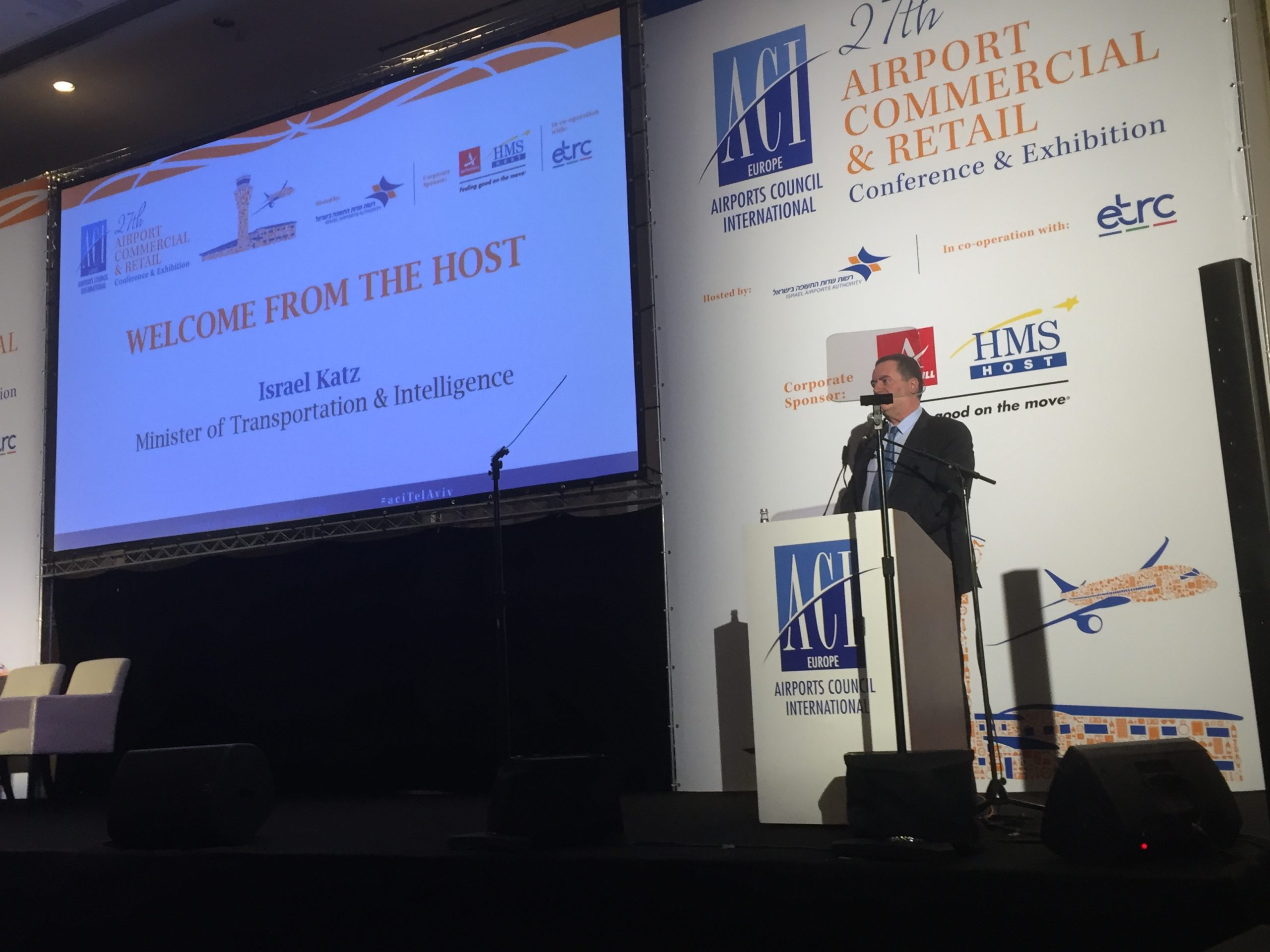
“We are not just waiting for travellers. We are adding the most advanced aviation infrastructure. We will soon open our new Ramon Airport in the south, to serve the many visitors who come to Israel in the winter months.”
Israel Airports Authority Chairman of the Board Eliezer Marum offered a frank perspective on the challenges facing commercial activities at Tel Aviv Ben Gurion Airport.
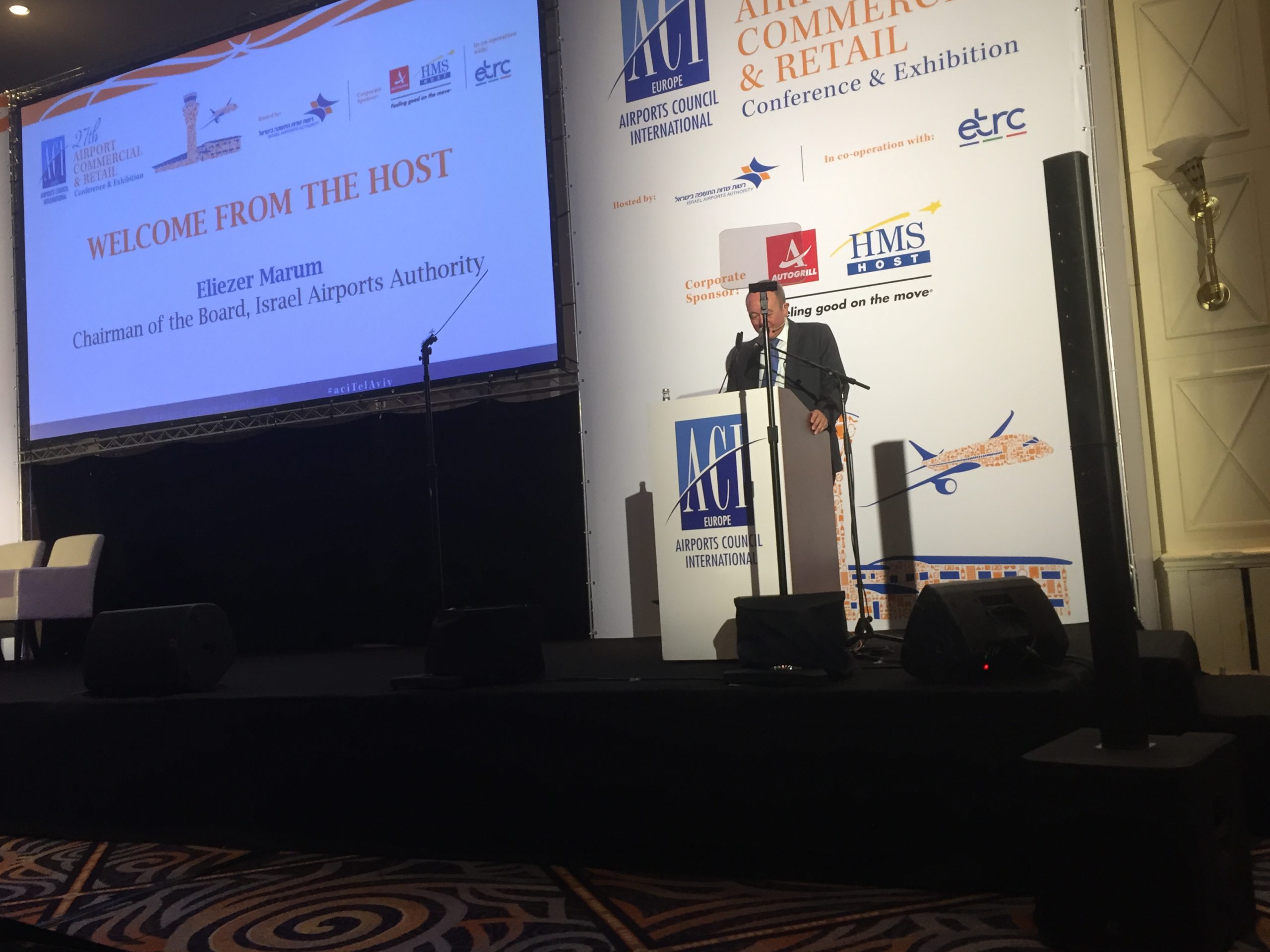
He said: “Our commercial business is suffering from the gap between growing numbers of travellers and the infrastructure expansion we need. We passed 20 million passengers in 2017, lifted by Open Skies policies, a strong economy and a strong currency relative to the US Dollar and Euro. We are hitting passenger growth of +15% a year. We will have 23 million passengers in 2018 and 25 million in 2019. In just three years we’ll hit close to 30 million. But the infrastructure gap is growing as we try to keep pace.
“We also face other problems as an industry. The first is e-commerce; people don’t want to go into shops. Also, those travellers who flew once a year now fly three or four times and they don’t buy as much. So this is a revolution in customer behaviour and we need to find solutions.”

Disruption in the aviation industry
ACI Europe Director General Olivier Jankovec delivered a concise state of the industry address.
“We are seeing an uplift in the European and global economy, which is good news for airports. The main drivers of growth continue to be low-cost carriers, though all types of airlines are adding capacity in the market. We see continued strong passenger growth rates and a stable oil price.
“But can the party continue? We see turbulence in geopolitics and doubts about the global trading system as the US imposes tariffs on steel imports, so what consequences will this bring? We also see existential threats to the EU for the first time, with Brexit a major risk. There is much uncertainty but at least a commitment to maintaining aviation connections and standards with the EU.”
He added: “We see more disruption ahead in aviation in 2018. This will be driven by structural changes in the market and changing technology. On the first issue, LCCs have moved upmarket now. If you take a ten-year view of Europe’s top airports, almost all of the growth has come from LCCs. The next step is low-cost long-haul, led by Norwegian. As an example they are putting more capacity into transatlantic routes than a legacy carrier like Air France. This is the perfect storm for legacy carriers who are responding by creating their own LCC model.
“We also see the Middle East carriers who were once the disruptors, but now are the incumbents. They see LCCs on long-haul routes as their major threat. All of this has an impact on airport relationships, as does airline consolidation.
“Airport competition is expanding all the time. Everybody is chasing the same airlines, first LCCS and then those growing non-EU airlines, followed by European legacy carriers.
“All of this puts pressure on non-aviation revenues. Airlines are on a drive to reduce airport charges. We see airlines also opposing airport investment and expansion and that is not good for passengers.”
On technology, Jankovec noted the importance of leveraging data to extract more revenues, and the rise of Millennials. This demographic group will be 50% of world travellers by 2020, he said, with an effect on consumption.


“As airports we are looking at the digital journey now. What impact will more digitalisation have on dwell time? If we are more efficient in our processes, what happens to dwell time? We are also confronted by the digital platforms such as Amazon and Google. They want to drive the consumer experience, but what is our role interacting with them today? That is an open question.
“We will see a new travel value chain, a reshaping of the airport business. We will have to rethink how we design our facilities and how to extract our revenues. We need to embrace disruption to maintain and future-proof our business.”
Brexit opportunity
ETRC President Sarah Branquinho highlighted two key issues facing the industry today: Brexit and the threat to duty free tobacco. “Brexit is an opportunity for the industry to win. We support moves to have early certainty on aviation regulations. Legal certainty and clarity are vital to the continued growth of commercial operations.
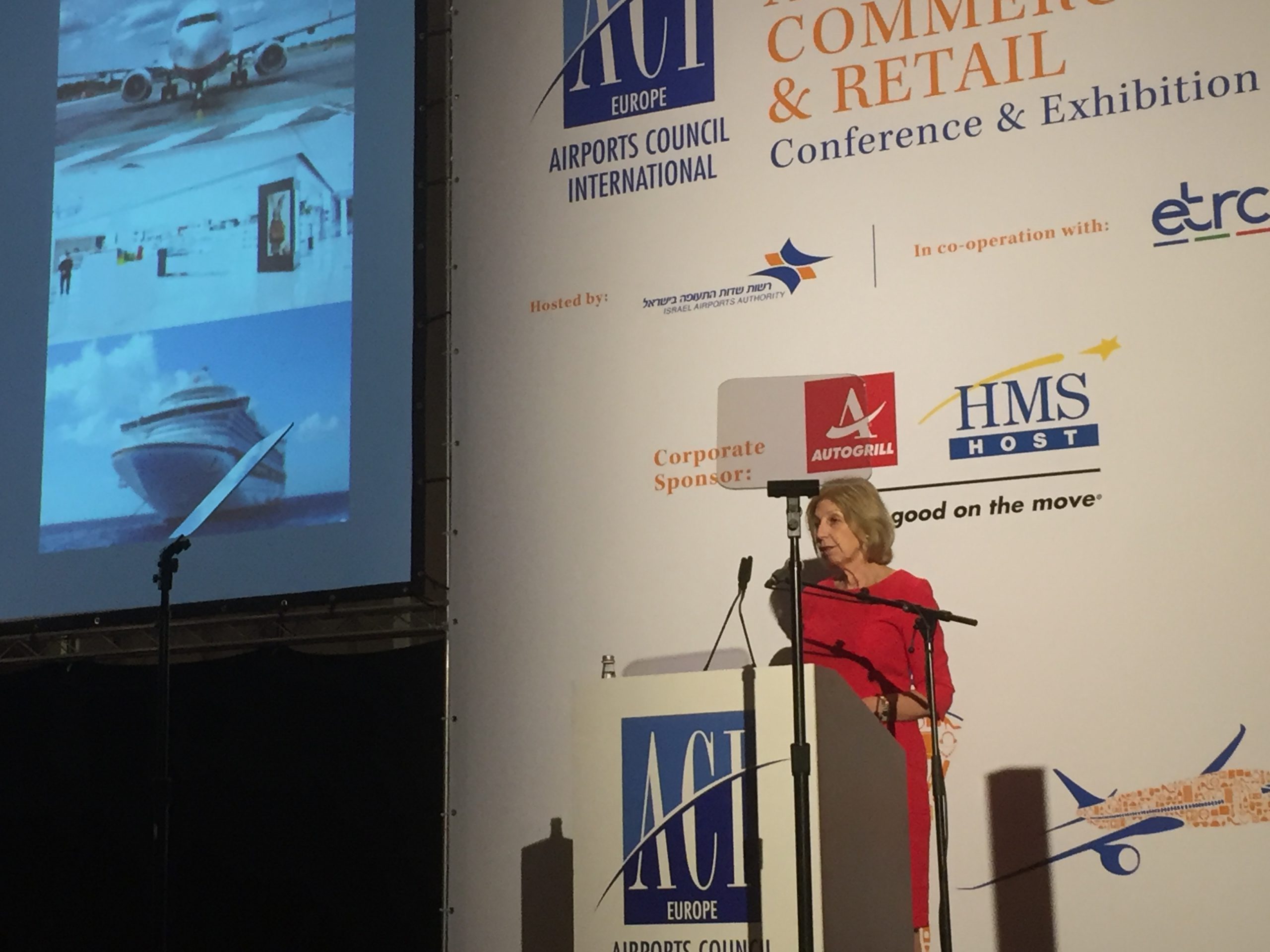
“We support a return of duty free sales between the UK and EU from the moment the UK leaves. Brexit offers a big commercial opportunity. There were 153 million air travellers between the EU and UK in 2016. There can be a halo effect across all categories, and duty free is highly significant for non-aeronautical revenues.”
Branquinho noted the threat to the industry from WHO’s Illicit Trade Protocol. “Our legitimate retail channel is under very real threat. The Protocol will probably enter force in October 2018 and it becomes legally binding on its signatories.”
The Protocol mandates that research should be undertaken within five years on “the extent to which” duty free contributes to illicit trade. Branquinho noted that ETRC and the Duty Free World Council support the major objectives of the Protocol but “reject unfounded allegations of involvement in illicit trade. Our members suffer from illicit trade but there is no justification for hurting legitimate retailers that do not contribute to illicit trade.”
Industry stakeholders need to act now, she noted. “We need airports to advocate that the research on duty free should not begin until other measures are implemented. We also need to build opposition with key industry allies and seek to remove any restrictions on duty free tobacco sales.
“It is essential that airports contact their governments to explain how duty free does not contribute to illicit trade. It’s not enough for your trade associations to lobby; airports must do so too. If we don’t, it is possible that we could see a total ban on duty free tobacco by 2021.”
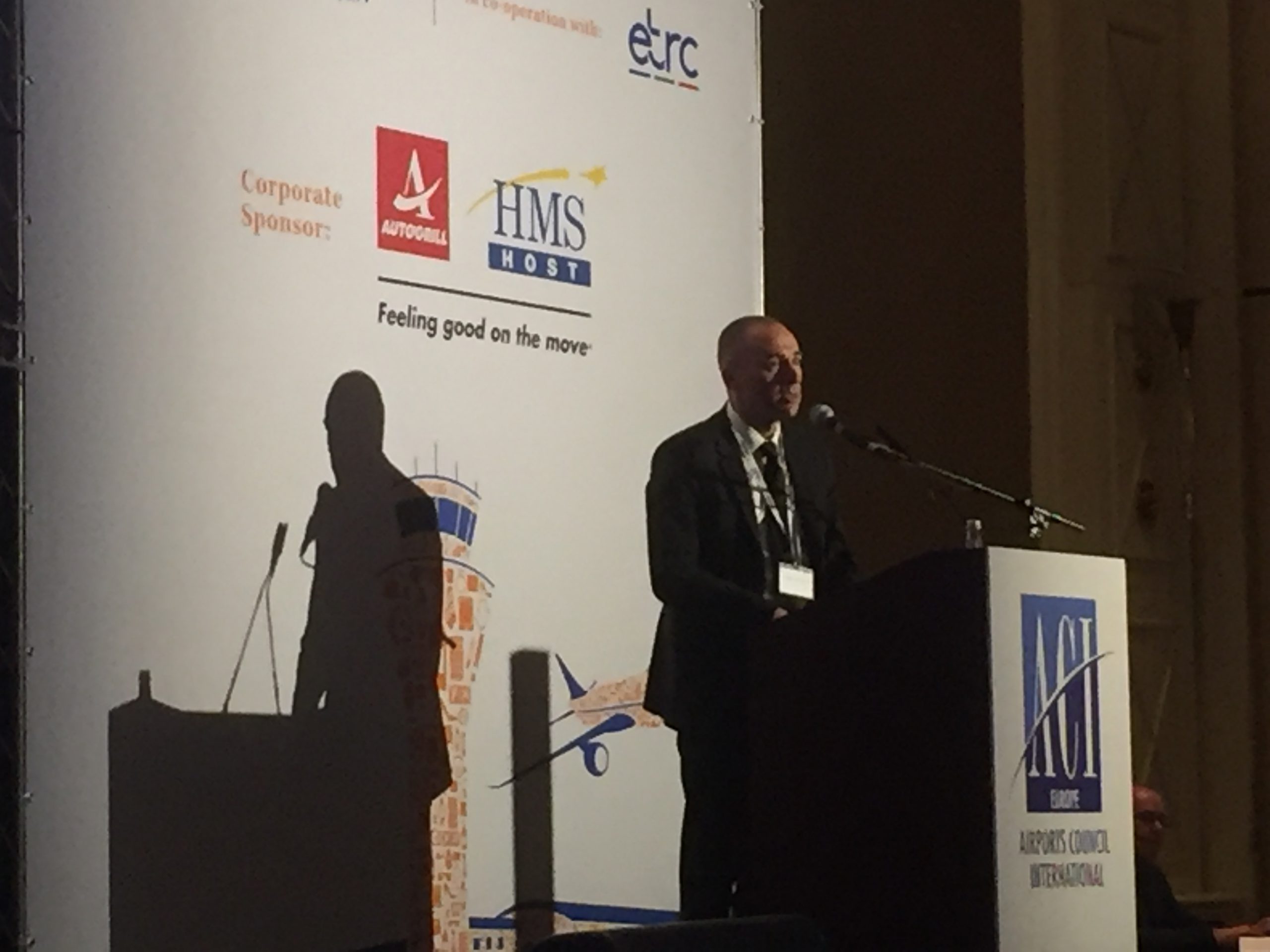
In a candid address, incoming El Al CEO Gonen Usishkin highlighted some of the challenges facing aviation today, with profitability is under pressure, price-sensitivity among customers and government regulation.
This led into a revealing session on commercial activities and development at Tel Aviv Ben Gurion Airport, led by Israel Airports Authority Deputy Director General – Commerce Business Development Yoram Shapira.
Shapira highlighted a global trend with the rise of e-commerce and the decline of the shopping mall. “People today want to research offline and buy online. Our challenge is to combine the digital and the physical. We must convince the customer to come to our shop and if they want, to then transact online.”
On Tel Aviv in particular, he noted a changing consumer base, with more frequent flyers and more children, but with fewer passengers spending. But on the upside, he noted that with more LCCS, the F&B opportunity is a growing one at airports. “We are seeing +15% growth in F&B sales, at least matching and sometimes above traffic,” said Shapira. “Also we see an opportunity in parking services. More families are flying and it’s easier for families to travel by car to the airport. In addition, businesspeople want more VIP services, especially at a crowded airport. They want exclusive services, from fast track to lounges, and we are taking this into consideration to develop new services.”
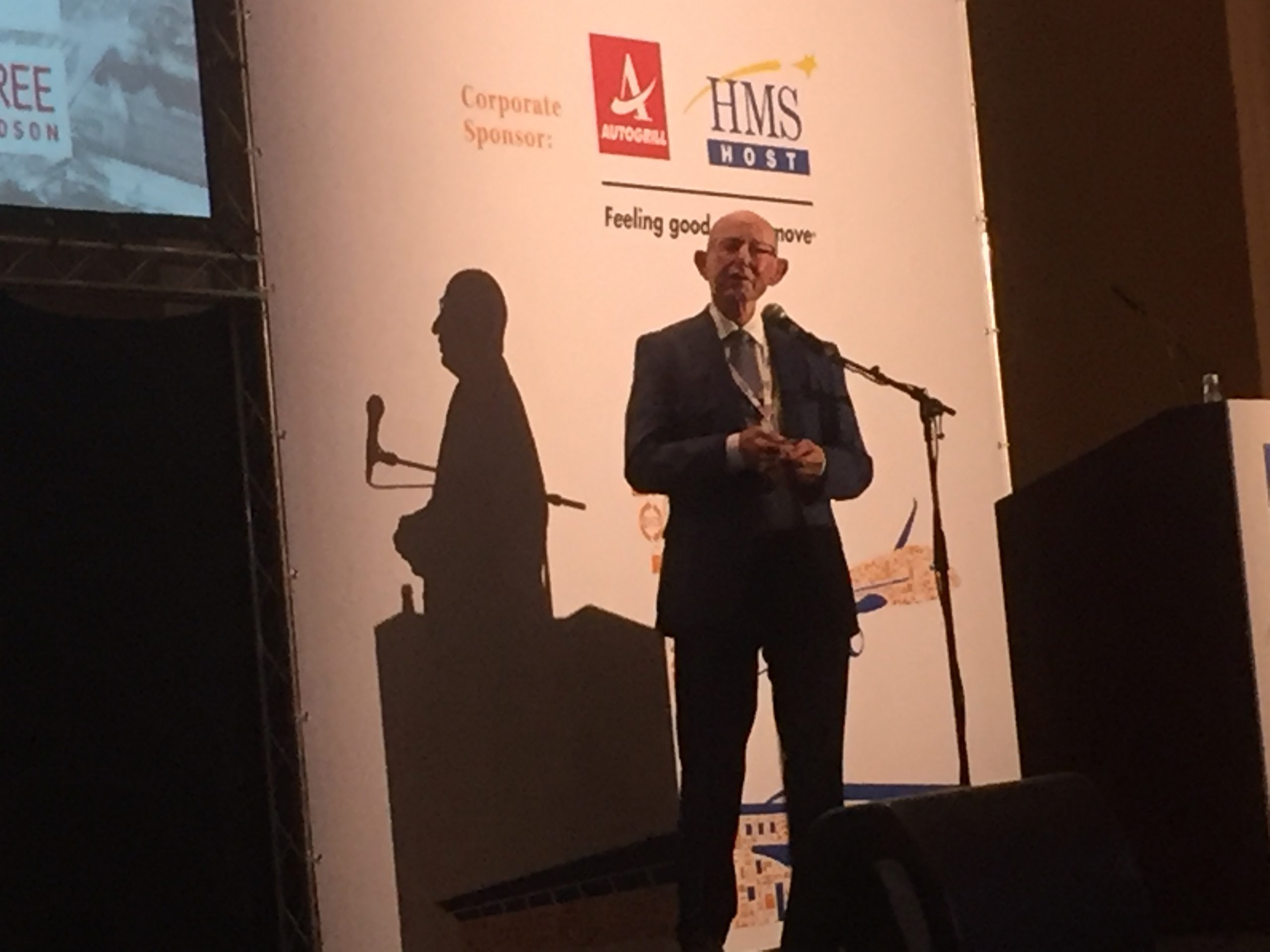
As solutions to today’s challenges, Shapira noted the roll-out of an ambitious marketing campaign called ‘Duty Freak’ which is running throughout Israel. He added that digital communications with the consumer are also being improved, with some important consequences for retail. “We will allow people to order before their flight, pay on arrival with your item ready when you land. We have to join the digital revolution.”
Tel Aviv Ben Gurion International Airport Managing Director Shmuel Zakay outlined the company’s moves to add capacity, as well as introduce new technology.
“First our story is a growth story,” he said. “From 8.7 million passengers in 2006 we had over 20 million in 2017. We serve 200 destinations in 60 countries. We have Open Skies agreements, we have no overnight curfew and we are a strategic destination – for example we are Turkish Airlines’ busiest location outside Turkey. We also have economic stability, plus we have invested in our infrastructure.”
Major recent projects include:
*The recently reopened T1, which is dedicated to low-cost airlines, a fast-growing segment at the airport;
*The new fourth concourse (E), just completed, with new stores and lounges;
*An upgrade of runways and taxiways to improve safety, reduce noise and improve environmental friendliness;
*A new air traffic control centre.
James Richardson Duty Free Chairman Garry Stock delivered a sharp, concise insight into the issues facing duty free in Israel and more broadly, challenged the prevailing industry contract model.
Current challenges facing duty free in the country, he said, include the elimination of purchase taxes on perfumes; reduced allowances on cigarettes; government turning a blind eye to parallel imports and changes to liquor tax rates that have put pressure on profitability in this category. Major price competition with the local market today is “savage” he said, while online retail (through discounters) also has a heavy impact on the duty free liquor business. In addition, in beauty in particular, there is strong competition from three major drug store chains on fragrances in Israel, which Stock said treat the category as a loss leader.
“Across the business we are seeing much heavier regulations, intensified competition and a revolution in air travel (more travellers). Duty free has moved being a protected species to a mature market today. Against that background, what actions do we need to make?”
First, he said, the retailer must do more, from pre-order to price transparency to delivering the right messages to the consumer at the right time. He highlighted the stunning success of JR Duty Free’s consumer marketing, notably through social media.
He added: “The second action is to pursue structural change in the industry. We have seen consolidation driving economies of scale, sharing of risk and maximising best practice. Those dynamics drove the JV we started on 1 January with Heinemann at Ben Gurion.”
A further priority relates to the airport-retailer relationship, he noted. “This relationship is often collaborative but cautious. We need to find true partnership and synergy, but how best to do this? The challenge is that there is not necessarily mutuality of interest.
“The airport should see retail as a business that needs a return and therefore must be developed. When you do that you see things differently, from the viewpoint of airport planning, the number of shops, where they are located, how we manage dwell time. It also opens up model of cooperation. Do I run it myself as an airport? Do I partner with one duty free operator or take a partner to manage the entire retail precinct?”

He said that the emphasis in contracts of the future must lean on percentage of sales and sales growth. “Arrangements that are built on MAGs tied to passenger numbers are really not helpful. It should be a safety net, but not an unreasonable one. There is no mileage in having a MAG tied to passenger growth when it does not develop with commensurate sales. After all, a passenger can be a Chinese tourist or a child on a school tour. The focus must be on a percentage of sales with both sides protected. We have to have more airport-operator partnerships. We must find ways to cooperate on marketing and capitalise on maximising our revenue.”
He concluded: “We have seen 30 years of dynamic change. Now we’re in a process of intense change in retailing in particular. Airports have a huge investment in retailing. That means airports must stand up and say they are prepared to adapt. Think out of the box strategically and tactically. They should be quicker on their feet – and operators must respond. The customer doesn’t need us for shopping; if we don’t act, we are inviting the possibility of extinction.”
On the company’s joint venture with Heinemann, Stock said: “We have strengths that we wanted to maintain. You also see what Heinemann have done in the past 15 years and we knew they were interested in Israel for many years. Importantly there was a feeling on both sides that we could work with each other. If you have two heads, it’s better than one. It’s satisfying to sit with colleagues of a high standard and review all we do appropriately and look at how we do things better. We see our already very strong range becoming even stronger, as we can access new products through Heinemann. We have already developed, with their input, a new queuing system that can service the business at busy times.
“We expect a more progressive improvement month after month, polishing the offer, and continuing to work on our digital strength, to encourage the younger market. We look forward to continued success with Heinemann.”

SSP Group Business Development Director Jonathan Robinson made a cogent argument about the vital role of F&B at airports. “We must plan F&B in a way that is integrated into retail,” he said. “Too often F&B is tucked away in less attractive space, yet it is often out-performing retail on a spend per passenger basis. So can we address this? How can we use F&B to disrupt travellers?
“Can we add a great café/bar in the heart of the retail area? It can attract travellers who are not currently interested in duty free. Let’s position F&B appropriately with relevant retail offer, with clear lines of sight between each.”
He encouraged airports to involve F&B partners as well as retailers in RFP planning to optimise the planned offer and mix.
In Tel Aviv, SSP has opened Camden Food Co adapted to the local travellers. “Sense of passenger is more important than Sense of Place. At many large hub airports 70% of passengers are in transit and it’s not so important to reflect the cuisine of the country they are passing through. They want a taste of what they know. There is a place for local, but let the passenger mix lead that.”
Israel Airports Authority Head of Business Development Gadi Rafaeli presented the new Ramon Airport, which opens later this year. It will open with capacity for 1.8 million travellers in year one. It will replace the existing Eilat and Ovda airports.
Unusually the airport mixes domestic and international passengers, which was a challenge when faced with Customs regulations and border control.
For duty free, the concessionaire (JR/Duty Free) must have two accounting systems for duty free and duty paid goods; two warehouses for products and gate delivery for international travellers.
“Now it’s a win:win for travellers,” said Rafaeli. “We have a great variety of stores and can maximise the utility of the departures hall and gates. Our vision is ‘build it and they will come’.”

Airport stores as showrooms
Addressing the question of whether airport stores are “showrooms for brands rather than shops” was a strong panel led by Mondelez World Travel Retail Head of Category Planning Ivo Knuesel. Speakers included TFWA President Erik Juul-Mortensen, Dufry Global Commercial Director Nigel Keal, Heathrow Airport Retail & Service Proposition Director Chris Annetts and AOE CEO Kian Gould.
Erik Juul-Mortensen noted that the airports could help brands recruit new consumers, and that brands contributed to the environment through their use of travel locations to engage with travellers.

But he added: “In its current shape we face higher margins that our domestic market counterparts. It means for brands that profitability is lower than on domestic markets. This structural deficit is one reason why brands launch lines that are only available in travel retail. We add value through differentiation. But there is a balance between encouraging travellers to trade up and the higher production costs of exclusives.
“In summary, I don’t agree that brands are using airports unfairly. We value the space and we pay a price for it. It is for good reason that the current business model is under scrutiny. A better balance of risk and reward is needed. If that does not happen, it’s not impossible that we could see brands redeploy their resources in other areas of the business.”

Nigel Keal offered a retailer’s view of the business today. He said: “Brands are tough. Their market has powerful consolidation, many are also retailers and many are luxury brands, not consumables. Travel retail is just one facet of their business. Retailers need to balance the demands of brands and airports.”
He added: “Once we had a business based on price, a captive audience and limited competition. Those things no longer apply in the way they once did.”
He added: “So where do we need to go now? Travel retail needs to excite and delight, and do as good if not a better job than domestic retailers. Airports generally don’t do that as well as the domestic market. Also, we are not encouraging niche brands to enter the market. We have to overcome this as a Trinity. Niche brands are often put off by the costs of doing business. We have to get better at delivering returns on space. Technology is a must and we can do better on loyalty programmes.
“We have to promote and instigate. We must become more customer-focused, leverage gifting and treating and encourage impulse purchasing. We have to create and market exclusives better, include more local products and lift the store environment, though here most travel retailers already do a very good job.”
Chris Annetts offered an airport view, noting that Heathrow has a long list of brands that still want space in which to trade.
“We recognise that the world is changing. Digital disruption is everywhere. Amazon in particular is changing the game. That’s a difficult model to overcome. So how can we do things differently?
“In the UK we see everything from home delivery to pre-order, things that make life easier for customers. Travellers want products they desire, easy to find and a good experience when they spend their money. But that is true of all retail. We have to work out how we as an industry should answer that challenge.
“Partly that means delivering the ‘experiential airport’. We have invested in digital capability, from Heathrow Maps to our Reserve & Collect system, which goes live next week with our partner AOE. Customers can see a range of products and services in one place, and know those are available for them. It’s something not many airports can do and will continue to make us relevant.”
Kian Gould asked: “How can you use the great branding opportunity you have in airports with accurate technologies to give the passengers what they want? In the past airports were only making sales during the journey, not before or after, and here technology can play a part.”

He said: “Omnichannel e-commerce is the ideal hybrid, combining the physical store with the web shop. Web-rooming is important: for every 100,000 visitors to our e-commerce platform, physical retail sales increased by €750,000. The impact is almost immediate.
“So are we doing enough to drive a brand experience pre-travel? Very few airports do this well. They are relying on impulse rather than pre-branding, which is more relevant.”
Gould outlined the power of digital by noting some best sellers in the web platform – Frankfurt Airport’s e-commerce platform sold five luxury Leica cameras in February, driven by being the only location selling these online, with strong viewership among Chinese travellers.
He added: “Heathrow might just be the only airport where you can sell a €35,000 watch – Jaeger LeCoultre is one of the top sellers at Heathrow online because where else can you buy such items on the Internet?”

Responding to a question from The Moodie Davitt Report, Annetts confirmed that many leading luxury brands had agreed to be present via the Heathrow omnichannel platform. “We recognise that the in-store experience is key, but many of these brands already have an online presence. Why shouldn’t airports be a part of that, via s tore that can offer a full range? There is nothing more disappointing than researching your product, expecting it to be in the store, but arriving and not having it available. The e-commerce platform helps address that.”
In the day’s final session, titled The Innovation Masterclass, speakers included Autogrill Chief Marketing Officer Ezio Balarini, Oslo Airport Commercial Director Maiken Skirstad Mo, JTI Worldwide Duty Free Corporate Affairs Manager Mariana Stangl Pinheiro, FLIO Chief Marketing Officer Roman Bach and Coindrum CEO Lukas Decker. The session was chaired by TRBusiness Senior Editor Andrew Pentol.
In a superb, forward-looking presentation, Ezio Belarini highlighted the vital importance of mobile in food ordering now and in the future, while also emphasising in-store digital touchpoints such as kiosks. “These touchpoints increase efficiency and sales in QSR restaurants, lifting our average ticket by double digits in all our regions,” he said.
Looking to the present and future of digital in the market, Belarini noted the recent partnership with Deliveroo for delivery at the gate at Schiphol Airport.

Other dynamics that will affect the industry will include usage of facial recognition; robot technology and mobile shops that are potentially solar-powered, self-driving, drone-equipped and always open. “Imagine these kinds of solutions in our environment. They don’t substitute what we do well already but they give passengers more control of their time and service when and where they need it.”
Maiken Skirstad Mo outlined the project that saw Oslo Airport expand Terminal 2 last year. Key outcomes included improved concession rates and the fact that some brands have become the best performers in their segments in the entire country.
But growth has been harder to come by in duty free, she noted. This is partly due to new passenger flows but also because passenger growth is coming from foreigners. “Norwegians are the best duty free customers in the world but our new passengers are foreigners and they spend -50% less than Norwegians.”
She also called for more transparent and partnership with retailers and brands to maximise the sales opportunity at airports.
Mariana Stangl Pinheiro addressed the question of tobacco’s relevance, noting that the category has a strong future in the airport market despite recent challenges to the sector. Crucially, she highlighted the higher than average per basket spend among tobacco shoppers, with 35% also buying alcohol, 22% also buying beauty and 23% also buying confectionery.
Roman Bach, one of the original investors in FLIO, covered the opportunity of the digital marketplace. FLIO now has 250,000 monthly active users, he said, and has become the most used airport app worldwide, he said. Apart from flight information, he noted, 15% of customers are using couponing in the app, and 3% are booking transport or lounges. These remain relatively low penetration levels, he added, but remained confident they would grow. “Our revenue per passenger are ahead of industry standards and we see this continuing. We are seeing huge growth in services, from parking to lounges. It is all about delivering convenience.”
Lukas Decker noted that Coindrum offered opportunity against the backdrop of low penetration in airports. “People have coins in their pockets that they take home and don’t use again. At our partner airports you can drop in your unused coins and receive a paper voucher, but with a +10% premium. That customer now has a further incentive to buy in duty free. That is what we are about, raising penetration in duty free.
“At one partner airport in Central Europe, we gave an average voucher worth €5.52 and on average they spent €65 average transaction value. So it’s not about the coins; our main transactions happen in duty free – the voucher is just the hook. That is also higher than average transaction values without Coindrum. We improve on average ATV. Why? Because those most attracted are long-haul travellers. Once they spend, they spend more, so this solution attracts the right shoppers. At this location it represents a category growth opportunity and we see that translating to other locations.”
Amid a recent phase of expansion, Decker said the company has recently tripled its footprint with Dufry in Milan and entered Dubai International with Dubai Duty Free.
The ACI Europe event concludes on Thursday with sessions on car parking and on innovation.
*Next year’s Airport Commercial & Retail event will be hosted in Iceland by Keflavik Airport company Isavia on 18-20 March.












